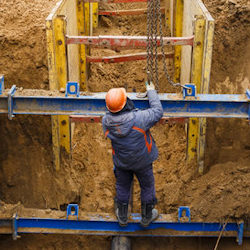Selecting Protective Systems
The following are a summary of the requirements contained in subpart P for excavations 20 feet or less in depth. Where the working area of an excavation is constantly moving, as in laying a conduit, shield systems or trench boxes may be the more appropriate protective devices to use.
Protective systems for use in excavations more than 20 feet in depth must be designed by a registered professional engineer in accordance with Sec. 1926.652 (b) and (c).
- Is the excavation more than 5 feet deep?
- YES - Is it entirely in stable rock?
- YES - Excavation may be made with vertical sides
- NO - Excavation must be sloped, shored, or shielded
- NO - Is there a potential for cave-in?
- NO - Excavation may be made with vertical sides
- YES - Excavation must be sloped, shored, or shielded
Sloping is selected as the method of protection.
- Will soil classification be made in accordance with Sec. 1926.652 (b)?
- YES - Excavation must comply with one of the following three options:
- Option 1: Sec. 1926.652(b)(3) which requires Appendices A and B to be followed
- Option 2: Sec. 1926.652(b)(3) which requires other tabulated data to be followed.
- Option 3: Sec. 1926.652(b)(4) which requires the excavation to be designed by a registered professional engineer.
- NO - Excavation must comply with Sec. 1926.652(b)(1) which requires a slop of 1 1/2H:1V (34 deg.).
Shoring or shielding selected as the method of protection.
Soil Classification is required when shoring or shielding is used. The excavation must comply with one of the following four options in Sec. 1926.652 (b) and (c):
- Option 1: Sec. 1926.652(c)(1) which requires Appendices A and C to be followed (e.g. timber shoring).
- Option 2: Sec. 1926.652(c)(2) which requires manufacturers data to be followed (e.g. hydraulic shoring, trench jacks, air shores, shields).
- Option 3: Sec. 1926.652(c)(3) which requires tabulated data (see definition) to be followed (e.g. any system as per the tabulated data).
- Option 4: Sec. 1926.652(b)(4) and Sec. 1926.652(c)(4) which require the excavation to be designed by a registered professional engineer (e.g. any designed system).
Knowledge Check Choose the best answer for the question.
4-7. Protective systems for use in excavations more than 20 feet in depth must be designed by _____.
You forgot to answer the question!

